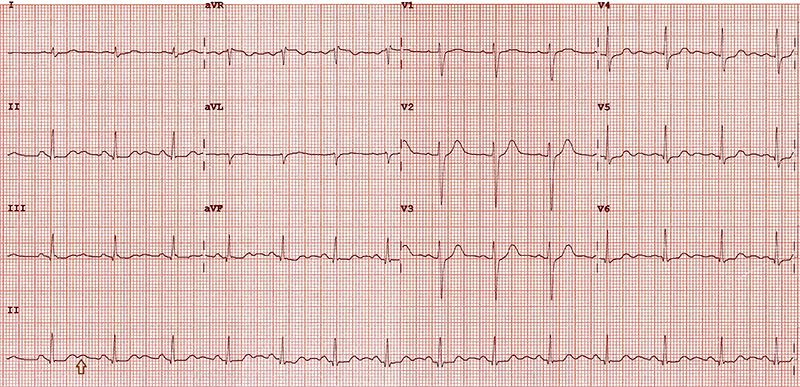The U-wave on electrocardiogram (ECG) is a small deflection following the T-wave, the sixth wave. It is 25% or less of the preceding T-wave in amplitude.1,2 While the genesis of the U-wave is uncertain, it is said to represent repolarisation of the Purkinje fibres.1,2 Disproportionally large U-waves may indicate underlying cardiac or non-cardiac pathology. A relatively frequent cause for a large U-wave is hypokalaemia. It is observed in patients with bradycardia, ventricular hypertrophy, hypothyroidism, hypocalcaemia, hypomagnesaemia, mitral valve prolapse, hypothermia, increased intracranial pressure, or patients on anti-arrhythmic medicine.2 A negative U-wave, on the other hand, may represent early myocardial ischaemia, specifically in the context of a lesion in the left main or proximal left anterior descending coronary artery.2,3
We recorded an ECG (figure 1) in a 50-year-old Caucasian woman when she attended our clinic for atypical chest pain and a history of familial hypercholesterolaemia. Her medication included atorvastatin and ferrous sulphate only. Cardiovascular examination was unremarkable. The ECG shows a very large U-wave, but was otherwise normal. Because of the disproportionally large U-wave, she underwent extensive investigations. Her echocardiogram, exercise stress echocardiogram and 24-hour Holter monitor were all normal. Her blood tests showed normal thyroid function, normal serum potassium (4.4 mmol/L) and calcium (2.4 mmol/L).

We found no evidence of possible causes for the large U-wave in this patient. This makes it possible that a giant U-wave can be innocent.
Conflicts of interest
None declared.
Funding
None.
Patient consent
The patient has given formal consent for us to report the case.
References
1. Papp C. The sixth wave of the electrocardiogram. Br Heart J 1940;2:9–24. https://doi.org/10.1136/hrt.2.1.9
2. Pérez Riera AR, Ferreira C, Filho CF et al. The enigmatic sixth wave of the electrocardiogram: the U wave. Cardiol J 2008;15:408–21. Available from: https://journals.viamedica.pl/cardiology_journal/article/view/21565
3. Verma N, Figueredo V, Greenspan A, Pressman G. Giant U waves: an important clinical clue. Research Reports in Clinical Cardiology 2011;2:51–5. https://doi.org/10.2147/RRCC.S18459
